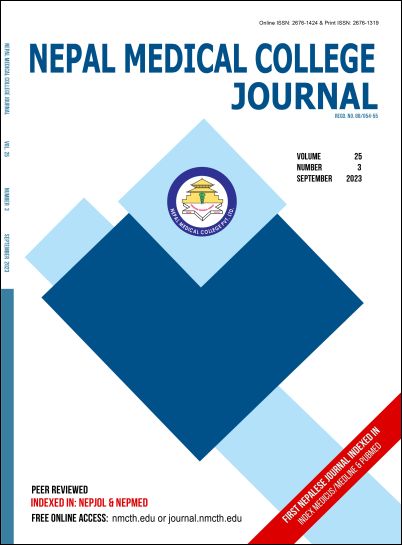A hospital-based study of dyslipidemia in patients with subclinical hypothyroidism
DOI:
https://doi.org/10.3126/nmcj.v25i3.58711Keywords:
Overt hypothyroidism, SCH, dyslipidemia, thyroid dysfunctionAbstract
Overt hypothyroidism usually leads to dyslipidemia. The relationship between overt hypothyroidism and dyslipidemia is well established, to that of subclinical hypothyroidism is controversial. Also, Subclinical hypothyroidism if untreated can lead to overt hypothyroidism. So, the present study was conducted to investigate dyslipidema in patients with subclinical hypothyroidism. The study population comprised of total 111 cases having subclinical hypothyroidism and 111 cases of healthy controls. Those with normal T3 and T4 with thyroid stimulating hormone above 4.68 IU/ml were considered subclinical hypothyroidism and were further evaluated for lipid profile. Highest number of participants in the cases belonged to age group 60-71 (36.0%) whereas in control group it was 40-49 years (32.4%). No significant differences were found between lipid parameters between case and control (p >0.05). Serum triglyceride, high density lipoprotein, very low-density lipoprotein was positively correlated with thyroid stimulating hormone (r=0.152, r=0.056, r=0.152, respectively and p=0.110, p=0.560, p=0.110, respectively) whereas total cholesterol, low density lipoprotein was negatively correlated with thyroid stimulating hormone in the cases (r=-0.089, r=-0.118, respectively) and the relation was not statistically significant (p=0.351, p=0.216, respectively). Among control group, serum total cholesterol, high density lipoprotein, low density lipoprotein were positively correlated with thyroid stimulating hormone (r=0.197, r=0.196, r=0.132, respectively) whereas triglyceride, very low density lipoprotein were negatively correlated with thyroid stimulating hormone (r=-0.009, r=-0.025, respectively). Subclinical hypothyroidism may or may not lead to dyslipidemia. Even euthyroid group can have lipid abnormalities. So, screening for hyperlipidemia in general population is more useful rather than patients with subclinical hypothyroidism.
Downloads
Downloads
Published
How to Cite
Issue
Section
License
Copyright (c) 2023 Nepal Medical College Journal

This work is licensed under a Creative Commons Attribution 4.0 International License.
This license enables reusers to distribute, remix, adapt, and build upon the material in any medium or format, so long as attribution is given to the creator. The license allows for commercial use.




